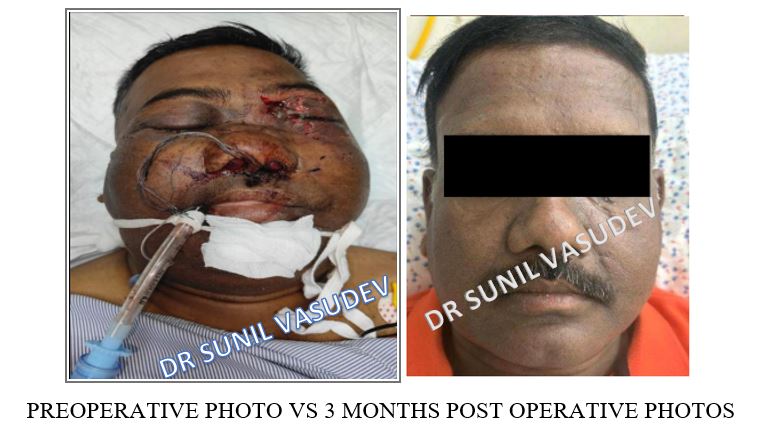“RISKS OF NOT WEARING A FULL HELMET: THE HIDDEN DANGERS OF TWO-WHEELER ACCIDENTS”
This is a case of two wheeler accident of a 40 year old male who was not wearing a full helmet. The patient was riding a two-wheeler when he collided with another one, causing him to fall face-first onto the ground. As a result, he sustained injuries to his face. However, he was wearing a half helmet, because of which, he was able to avoid severe head injuries. Patient was brought to our casualty with loss of consciousness and disorientation. He had multiple facial fractures risking his airway. An immediate intubation was done to secure his airway and was shifted to intensive care unit where he was stabilized. As he had major bleeding, 3 units of packed red blood cell transfusion was done.
CT revealed fractures of orbit, nasal bone, upper jaw, lower jaw which restricted him from opening of eyes, mouth and difficulty in breathing.

CT REVEALING MULTIPLE FACIAL FRACTURES
SURGICAL INTERVENTION
To secure a long term airway and also to provide unimpeded ventilation, tracheostomy was performed prior to surgery.
We, along with neurosurgery team performed an intensive surgery where multiple titanium mini plates and screws were used to retrieve patient’s facial symmetry and function.
POST OPERATIVE CARE
The patient was closely monitored for any post-operative complications including infection, bleeding, airway obstruction, tracheostomy site infections. On the course of 1 month of admission patient was put on multiple antibiotic therapy to overcome tracheostomy site infection, everyday monitoring of haemoglobin was performed. Adequate surgical wound care, nutritional support was provided.
OUTCOME
After 1 month of hospitalization patient was discharged without any complications.
Follow up visits confirmed that:
- Patient has adequate mouth opening with restored jaw movements, occlusion and speech. Also he regained his eye movements with intact vision and no obstruction in breathing.
- There were no signs of infection or other complications associated with the surgery.
CONCLUSION
This case highlights the importance of using full helmet in avoiding life threatening situations. Helmets are not just an accessory; they are a vital piece of safety equipment that significantly reduces the risk of severe head injuries in the event of an accident. In this case, the patient was wearing only a half helmet which helped him from impact of severe head injuries at the same time it didn’t help the patient from critical facial injuries. Every ride, no matter how short, carries a risk.
A full helmet covers the entire head, offering enhanced protection to the skull, face, and neck. This added coverage can prevent severe head trauma, reduce the risk of facial injuries, and even protect the spine in some cases. In high-impact accidents, a full helmet absorbs much more force, reducing the likelihood of life-threatening injuries. Choosing a full helmet over a half helmet is a simple yet crucial step in ensuring your safety on the road.
